High-Speed, Fiber-Optic, Digital Reference Transmitters
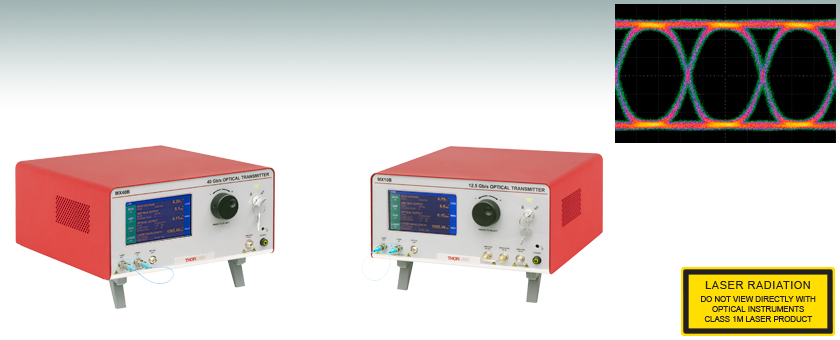
- Digital Reference Transmitters for 12.5 or 40 Gb/s Bit Rates
- Integrated Limiting RF Amplifier and Modulator with Bias Control
- Integrated C-Band Tunable, L-Band Tunable, or 1310 nm Laser
- Support High-Speed RZ, NRZ, and OOK Modulation Applications
MX40B
40 Gb/s Digital Reference Transmitter
Internal C-Band Tunable Laser
MX10B-LB
12.5 Gb/s Transmitter
Internal L-Band Tunable Laser
15 Gb/s Eye Diagram from the MX10B

Please Wait
All Reference Transmitters Include:
- Mach-Zehnder Intensity Modulator
- Bias Controller with Manual and Fully Automatic Operation Modes
- RF Amplifier
- Integrated C-Band Tunable, L-Band Tunable, or 1310 nm Fixed-Wavelength Laser (Contact Tech Support for an 850 nm Fixed-Wavelength Laser)
- Variable Optical Attenuator (VOA) for Automatic or Manual Power Control
| Key System Specificationsa | |||
|---|---|---|---|
| Item # | MX10B Series | MX40B Series | |
| Amplifier Type | Digital (Limiting) | ||
| Bit Rate (Maximum) | 12.5 Gb/s | 40 Gb/s | |
| Internal Laser Wavelength | C-Band, L-Band, 1310 nmb | ||
| Internal Laser Output Power (Typ.) |
13.5 dBm | ||
| External Input Laser Wavelength Rangec |
1250 nm - 1610 nm | ||
| Amplifier RF Output Swing (User-Adjustable) |
3 V to 7 V | ||
| Low Frequency Cutoff | 100 kHz | ||
| RF Amplifier Gain | 34 dB | 30 dB | |
| RF Optical Extinction Ratio | 13 dB (Typical Maximum) | ||
| Modulator Type | Intensity | ||
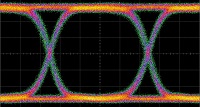
Click to Enlarge
10 Gb/s Eye Diagram from MX10B Series
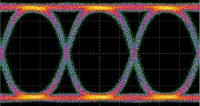
Click to Enlarge
15 Gb/s Eye Diagram from MX10B Series

Click to Enlarge
20 Gb/s Eye Diagram from MX40B Series

Click to Enlarge
40 Gb/s Eye Diagram from MX40B Series
Features
- Turnkey Reference Transmitter Solution
- Digital (Limiting) RF Amplifier
- Adjustable Optical Extinction Ratio
- Integrated Laser, Intensity Modulator, and Optical Power Control
- External Loop-Back Cables Support Custom Configurations
- Control via Intuitive Touchscreen Interface or Remotely Using USB or RS-232 Connections
- Custom Configurations Available by Contacting the Ultrafast Optoelectronics Team
Thorlabs' all-in-one digital reference transmitters are based on proven lithium niobate (LiNbO3) modulator technology driven by high-fidelity RF amplifiers. They are designed for high-speed fiber optic test and measurement applications. These user-configurable systems integrate a Mach-Zehnder intensity modulator (MZM) with fully featured bias control, a tunable or fixed-wavelength laser source, RF amplifier, and variable optical attenuator.
The transmitters on this page are based on the use of a high-gain, limiting amplifier with user-adjustable output voltage swing. These instruments are ideal for use in either an R&D laboratory or in a manufacturing environment for digital applications that require bit rates up to 12 Gb/s (MX10B series) or 40 Gb/s (MX40B series). Both series are well suited to many binary modulation formats, including return-to-zero (RZ), non-return-to-zero (NRZ), and on-off keying (OOK).
Because of their high gain, the transmitters can accommodate a wide range of input voltages. In these devices, the gain is always held constant and only the output voltage swing applied to the modulator is adjustable. This allows the user to control the optical extinction ratio of the signal from the modulator. The user can also adjust the eye-crossing points, which enable fine control of the eye transitions.
Internal Laser
Each reference transmitter has a built-in telecom-grade laser. Internal C- and L-band lasers are tunable on the ITU 50 GHz grid and incorporate a frequency offset option for fine tuning by ±30 GHz in increments of 1 MHz. A dither feature for wavelength stabilization is available in both tunable internal laser options (see the Operation tab for more information). An internal 1310 nm fixed-wavelength laser is also available as an option for all reference transmitters. Digital reference transmitters with an integrated 850 nm fixed-wavelength laser are also available upon request (contact Tech Support). An external laser source between 1250 and 1610 nm can also be used to provide the optical input.
System Connections
The laser input port uses PM fiber with light linearly polarized along the slow axis (aligned to the connector key) and can accept a maximum input power of 20 dBm (100 mW). Each fiber bulkhead accepts FC/PC connectors. The amplifier RF port connector type is either SMA or 2.92 mm (K), depending on the bit rate response of the device. See the Front & Back Panels tab for more information.
We offer a selection of microwave cables and adapters for incorporating these transmitters into a system.
Control
These reference transmitters can be controlled in two ways. The simplest method is using the intuitive touchscreen interface, which gives the user complete control over all instrument functionality. These instruments can also be operated remotely via the RS-232 or USB ports on the back panel. The Operation tab describes the graphical user interface (GUI) and user-customizable features, and we provide a remote control user guide and a remote control software tool (see the Software tab) for download.
We also offer linear reference transmitters with speeds up to 65 GHz. and optical transmitters based on phase modulators. Please see the Selection Guide tab above for all of our transmitter instruments.
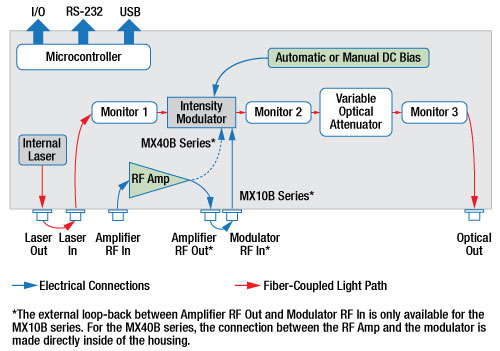
Click for Details
Block diagram showing the internal setup of the high-speed, digital reference transmitters.
See the Operation tab for details.

Janis Valdmanis, Ph.D. Optics
Ultrafast Optoelectronics
General Manager
Got Questions?
Our engineers and expertise are here for you!
If you are not sure whether our catalog items meet your needs, we invite you to contact us. Or ask about a loan, so you can try them out for yourself, in your own lab. We can also support custom or OEM requirements you may have.
Just press the button, and we'll get back to you within the next business day.
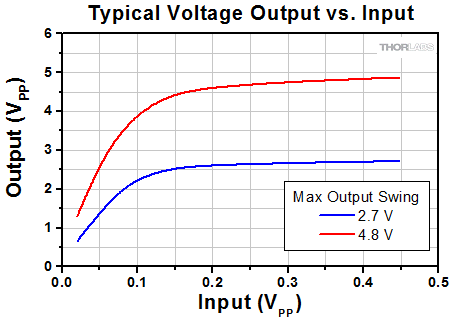
Click to Enlarge
Limiting amplifiers in the MX10B and MX40B series provide high gain and a user-adjustable output swing in 0.1 V increments.
| System Specifications | |||
|---|---|---|---|
| Series | MX10B Series | MX40B Series | |
| Amplifier Type | Digital (Limiting) | ||
| Usable Bandwidth | 12.5 Gb/s | 40 Gb/s | |
| Internal Laser | Three Options - See Table Below | ||
| External Lasera | Wavelength Rangeb | 1250 nm - 1610 nm | |
| Optical Input Power | 20 dBm (Max); 22 dBm (Absolute Max) | ||
| Optical Output Powerc | 8.5 dBm at 1550 nm 6.5 dBm at 1310 nm |
||
| Power Calibration Points | 1310 nm, 1550 nm, and 1590 nm | ||
| RF Optical Extinction Ratio | 13 dB (at 12.5 Gb/s) | 13 dB (at 40 Gb/s) | |
| Modulator Type | Intensity | ||
| Modulator Drive Voltage (Vπ) | 5.5 Vpp | ||
| Optical Insertion Loss | 5 dB (1550 nm); 7 dB (1310 nm) | ||
| Small Signal Bandwidthd | 7 GHz | 20 GHz | |
| Low Frequency Cutoff | 100 kHz | ||
| Electrical Return Loss | -10 dB (Any RF Port, Typical) | ||
| Amplifier RF Input (Digital Mode) | 400 mVpp (Typical) 3.5 Vpp (Max) 4 Vpp (Absolute Max) |
400 mVpp (Typical) 4 Vpp (Max) 6 Vpp (Absolute Max) |
|
| RF Amplifier Gain | 34 dB | 30 dB | |
| Internal Laser Specificationsa | |||
|---|---|---|---|
| Item # Suffix | N/A | -LB | -1310 |
| Laser Type | C-Band Tunable | L-Band Tunable | Fixed Wavelength |
| Wavelength Range | 1527.6 - 1565.5 nm | 1570.0 - 1608.8 nm | 1310 nm |
| Frequency Range | 191.50 - 196.25 THz | 186.35 - 190.95 THz | - |
| Optical Output Power | 13.5 dBm | 13.5 dBm | 13.5 dBm |
| Frequency Accuracy | ±1.5 GHz | ±1.5 GHz | - |
| Tuning Resolution | 50 GHz | 50 GHz | N/A |
| Fine Tuning Resolution | 1 MHz | 1 MHz | N/A |
| Tuning Speed (Between Wavelengths) | 10 s | 10 s | N/A |
| Fine Tuning Range | ±30 GHz | ±30 GHz | N/A |
| Side Mode Suppression Ratio | 55 dB | 55 dB | 35 dB (Min) |
| Optical Signal Noise Ratio | 60 dB | 60 dB | - |
| Intrinsic Linewidth | 10 kHz | 10 kHz | 2 MHz |
| Relative Intensity Noise | -145 dB/Hz (Max) | -145 dB/Hz (Max) | - |
| Back Reflection | -14 dB (Max) | -14 dB (Max) | - |
| Polarization Extinction Ratio | 18 dB (Min) | 18 dB (Min) | 20 dB |
| Power Monitor and VOAa Specifications | ||
|---|---|---|
| Power Monitor Accuracyb | ±0.5 dBm at 1550 nm | |
| Power Monitor Resolutionb | 0.01 dBm | |
| Power Monitor Insertion Loss | 0.1 dB (Typical) per Monitor | |
| VOA Attenuation Range | 1 dB - 20 dB | |
| VOA Response Time | 1 s | |
| Power and Environmental Specifications | ||
|---|---|---|
| Parameter | Min | Max |
| Main AC Voltage | 100 VAC | 250 VAC |
| Power Consumption | - | 60 VA |
| Line Frequency | 50 Hz | 60 Hz |
| Operating Temperature | 10 °C | 40 °C |
| Storage Temperature | 0 °C | 50 °C |
| Humiditya | 5% Relative Humidity | 85% Relative Humidity |
System Overview
These Digital Reference Transmitters are fully integrated and contain both the laser source and the lithium niobate (LiNbO3) Mach-Zehnder intensity modulator; the only required external input is the signal source to the Amplifier RF In port. Either the internal laser or an external laser source may be coupled to the Laser In port, which can be seen at the bottom-left corner of the diagram below. This port uses polarization maintaining (PM) fiber with light linearly polarized along the slow axis, as shown on the front panel of the instrument. Optical power is monitored in three places (Monitor 1, Monitor 2, and Monitor 3) for the purpose of enabling bias and power control. These power values are also available at the I/O port. Monitor 1 is at the laser input, Monitor 2 is at the output of the modulator, and Monitor 3 is at the final optical output.
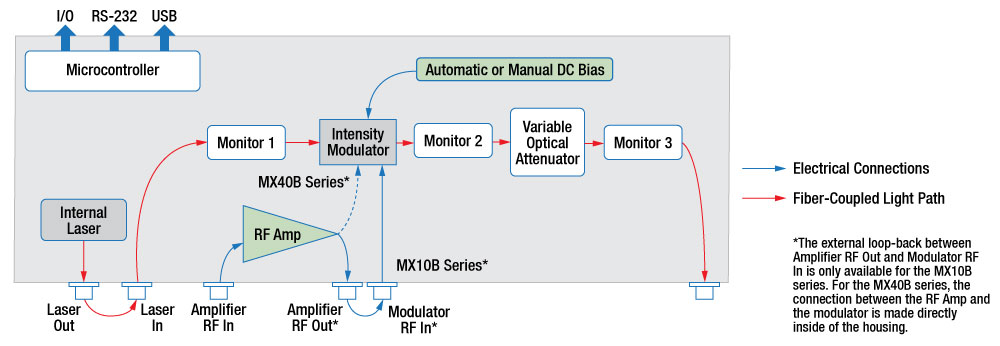
A Block Diagram of the Internal Setup of the High-Speed, Digital Reference Transmitters
Instrument Control
The graphical user interface (GUI) gives the user complete control over all instrument functionality. It is a resistive touchscreen display sensitive to both finger pressure and taps from a plastic stylus. The knob on the front panel of the housing can be used in place of the on-screen arrow buttons for quickly changing set-point values. Pressing (clicking) the knob will confirm a new set-point value. Additionally, the instruments can be driven using serial commands delivered via connectors on the rear panel.
The home screen of the MX10B series is shown in Figure 1. It is organized into three main sections:
- Left Column:
- Buttons show the on/off status of the different instrument functions.
- Tap a button to toggle the function on/off.
- Middle Column:
- Current operating parameters of each control function are shown.
- Tap in this column to access the Settings page for each function.
- Right Column:
- Buttons provide access to various utility and help functions.
- Tap to review and customize system settings.
The green dot that appears in the upper-right of the center column panels indicates that those functions are stable. The dot will blink if that function is still stabilizing.
Functions and controls enabled by the GUI are further discussed in the following sections.
Laser and System Wavelength Settings
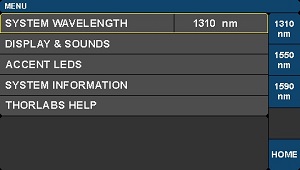
Click to Enlarge
Figure 3: System Wavelength Selection Screen
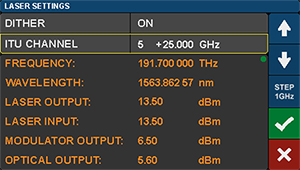
Click to Enlarge
Figure 2: Laser Settings Screen
The laser setting screen shown in Figure 2 is accessed directly from the home screen. Each instrument includes a C- or L-band telecom-style laser that is tunable on the ITU 50 GHz grid or a 1310 nm fixed-wavelength laser. An 850 nm fixed-wavelength laser can be substituted by contacting Tech Support. C-band and L-band lasers also support a fine tuning frequency offset feature, allowing the frequency to be adjusted by an offset from -30.000 GHz to +30.000 GHz in increments of 1 MHz. ITU Channel wavelengths are indexed for convenience; use the arrow buttons to step through the indices to select the desired wavelength.
This screen also allows the user to control whether or not the dither feature (available for tunable C- and L-band lasers only) is used to stabilize the wavelength. Turning dither off results in lower phase and intensity noise (see the Specs tab for a representative plot), but doing so may also result in the wavelength drifting slightly over time. If an external laser is used, the internal laser can be turned off by tapping the laser button on the home screen.
If an external laser is used, it may be necessary to change the power monitor calibration settings. These instruments can be used at wavelengths anywhere between 1250 nm and 1610 nm, and calibration settings are supplied for three wavelengths: 1310 nm, 1550 nm, and 1590 nm. These wavelengths represent the centers of the O-Band, C-Band, and L-Band. The default calibration setting corresponds to the wavelength range of the internal laser. If operating outside that wavelength range, change the power monitor calibration settings by tapping the Menu button on the home page. Select the System Wavelength setting, shown in Figure 3, to change the power monitor calibration wavelength to the value closest to the wavelength of the laser source being used.
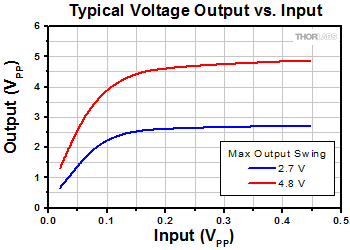
Click to Enlarge
Figure 5: Limiting amplifiers in the MX10B and MX40B series provide high gain and a user-adjustable output swing in 0.1 V increments.
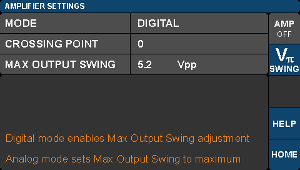
Click to Enlarge
Figure 4: Digital RF Amplifier Settings Screen for the MX10B and MX40B Series
Limiting RF Amplifiers
The amplifiers used in the MX10B and MX40B series have “limiting” characteristics once a certain output voltage swing has been reached. This enables cleaner transmission of two-level digital signals. In addition, the peak-peak output swing can adjusted to control the extinction ratio (ER) of the output optical signal. These controls can be accessed from the Amplifier Settings page shown in Figure 4. The relationship between the input and output signals is shown in Figure 5. Small signals experience high gain, but as the signal level increases, the output signal swing is limited at the chosen set point.
For small input signals (before the amplifier limits), these instruments can actually be operated in analog mode. In this mode, the Output Swing is automatically set to its maximum value so that the linear gain region is maximized. Note that this only works if the input signal swing is kept small enough not to saturate the amplifier. See the manual for details.
The eye crossing point can be also adjusted during both digital and analog mode operation. A set point of 0 specifies a 50% crossing, which corresponds to the point midway between the signal's maximum and minimum values. Set points of -100 and +100 specify 35% and 65% crossings, respectively.
Modulator Bias Controller
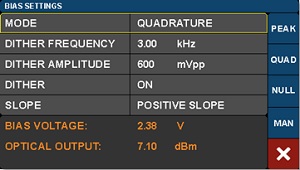
Click to Enlarge
Figure 7: Bias Settings Screen
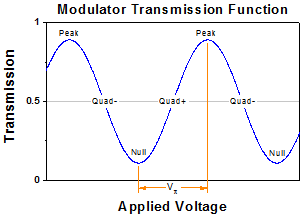
Click to Enlarge
Figure 6: Bias Points for an Intensity Modulator, in which Vπ is the Half-Wave Voltage
There are four bias control modes, which provide the option of operating with fully automatic bias control or under manual control. Three of the four automated operating modes, Peak, Quadrature, and Null, reference the regions labeled on the modulation transmission function, which is illustrated in Figure 6. When one of these modes is selected, a dither tone is used to hold the modulator at the respective bias point. The dither tone is part of a lock-in approach that maintains a stable bias point by compensating for modulator drift, which occurs over time due to the temperature sensitivity of the modulator. The dither tone can be set to a frequency between 1 and 10 kHz, and the amplitude of the tone can also be selected. Quadrature mode gives the option of operating on either the positive or negative slope of the function.
For those applications that require an automated, but ditherless, approach to maintaining a stable bias set point, select the Constant Ratio mode. It is enabled by tapping the MAN function on the right of the screen shown in Figure 7 and configuring the Ratio Set Point and Slope values. This mode adjusts the bias voltage to maintain a chosen ratio between the intensity values reported by Monitor 1 and Monitor 2. The Slope setting allows the user to choose whether increasing voltage on the modulator increases or decreases the optical output power.
It can be useful to operate for brief periods of time at a bias fixed voltage and without a dither tone. A fixed bias voltage can applied in one of two ways. When operating in Quadrature, Peak, or Null modes, tapping the value of Dither will toggle it between on and off states. When dither is toggled off, the value of the fixed bias voltage is held at the most recent automated bias voltage. This enables the user to make quick measurements, without the dither tone present, while the modulator is biased at one of the common modulator transmission function set points. The Constant Bias mode can also be accessed by tapping the Mode value and then the MAN function on the right of the screen. This page allows either the automated Constant Ratio or fixed-voltage Constant Bias modes to be enabled and configured.
Variable Optical Attenuator
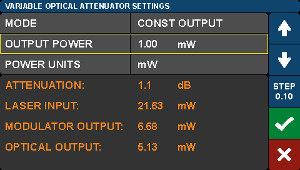
Click to Enlarge
Figure 8: VOA Settings Screen
The VOA provides the means for adjusting and stabilizing the modulated optical output power. The VOA settings screen, which is shown in Figure 11, allows the user to choose between and adjust the parameters of the two operational modes. In Constant Attenuation mode, the attenuation level between the Return from Modulator input port and the Final Optical Output port is fixed, which allows power fluctuations at the input of the power controller to be transferred to the output. In Constant Output Power Mode, the final optical output power is held constant independent of the input fluctuations. In this mode, the VOA is effectively used as a power stabilizer. Tap the Step function button at the right of the screen to change the step size by which the arrows increment or decrement the set point values.
The VOA settings screen also allows the user to select the units used to report the power readings and parameters on all pages. Use the Power Units field to choose whether power values are reported as mW or dBm.
Rear Panel
The rear panel provides additional safety and utility functions such as the laser safety interlock and the power monitor output, RS-232, and USB ports. The USB interface is currently used only for firmware upgrades that are made available on Thorlabs website. Future revisions of the firmware will provide for remote control of the instrument's functions.
All units are shipped from Thorlabs with a shorting device that is already installed in the interlock connector, thus allowing the instrument to be operated normally right out of the box. To make use of the interlock feature, a 2.5 mm plug can be wired to the remote interlock switch and plugged into the back-panel interlock jack in place of the shorting plug. Electrical specifications for this function are provided in the manuals, which can be accessed by clicking on the red document icons (![]() ) below.
) below.
Front Panels
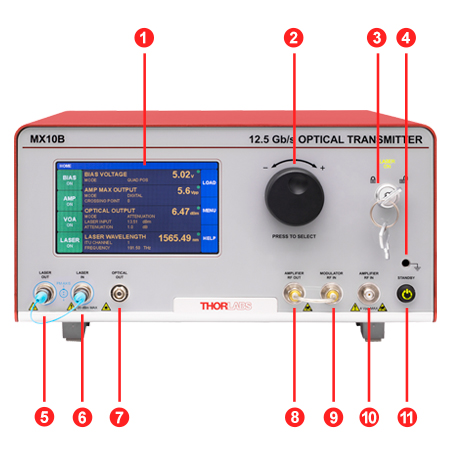
Click to Enlarge
MX10B Reference Transmitter Front Panel
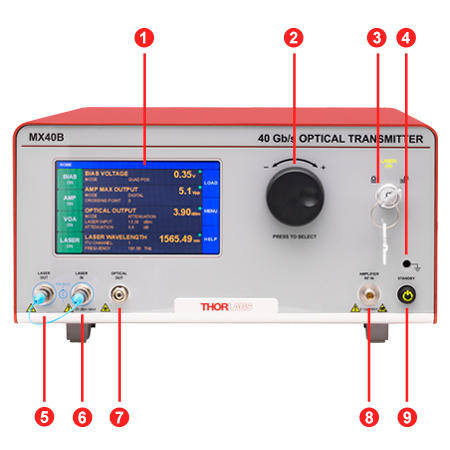
Click to Enlarge
MX40B Reference Transmitter Front Panel
| Front Panel of the MX10B Series | |
|---|---|
| Callout | Description |
| 1 | Touchscreen Display and Control |
| 2 | Value Adjustment Knob |
| 3 | Key Switch and Indicator Light for Internal Laser |
| 4 | Earth Ground Port for ESD Wrist Strap Banana Plug |
| 5a | Laser Out for Internal Laser Source, Accepts PM Fiber with FC/PC Connector (Narrow Key) |
| 6a | Laser In to Modulator, Accepts PM Fiber with FC/PC Connector (Narrow Key) |
| 7b | Optical Out: Final Output from Modulator, FC/PC Connector (Narrow Key) |
| 8 | Amplifier Out: Signal from Internal Amplifier, SMA Female |
| 9 | Modulator RF In: Signal to Modulator, SMA Female |
| 10 | Amplifier RF In: Signal Input to Amplifier, SMA Female |
| 11 | On/Standby Button |
| Front Panel of the MX40B Series | |
|---|---|
| Callout | Description |
| 1 | Touchscreen Display and Control |
| 2 | Value Adjustment Knob |
| 3 | Key Switch and Indicator Light for Internal Laser |
| 4 | Earth Ground Port for ESD Wrist Strap Banana Plug |
| 5a | Laser Out for Internal Laser Source, Accepts PM Fiber with FC/PC Connector |
| 6a | Laser In to Modulator, Accepts PM Fiber with FC/PC Connector |
| 7b | Optical Out: Final Output from Modulator |
| 8 | Amplifier RF In: Signal Input to Amplifier, K™ Female |
| 9 | On/Standby Button |
Back Panel
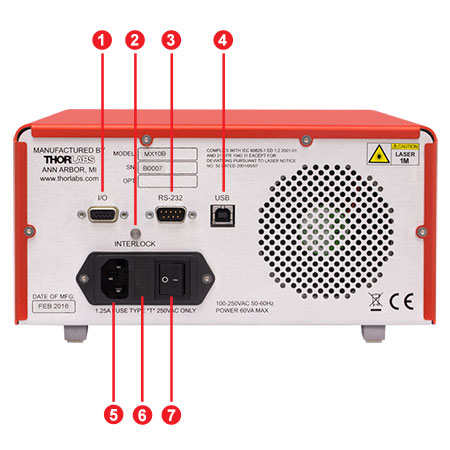
Click to Enlarge
The back panel format is the same for each high-speed reference transmitter.
| Back Panel of all Reference Transmitters | |
|---|---|
| Callout | Description |
| 1a | I/O Control Port Outputs from Three Integrated Power Monitors |
| 2 | Laser Interlock Jack |
| 3a | RS-232 Control Port |
| 4 | USB Port (Type B) |
| 5 | AC Power Cord Connector |
| 6 | Fuse Tray |
| 7 | AC Power Switch |
I/O DB15 Connector
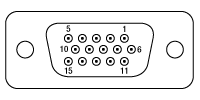
The I/O connector provides analog outputs from the three power monitors.
| Pin | Description | Pin | Description |
|---|---|---|---|
| 1 | Power Monitor 1 | 9 | Analog Ground |
| 2 | Power Monitor 2 | 10 | Analog Ground |
| 3 | Power Monitor 3 | 11 | Reserved for Future Use |
| 4 | Reserved for Future Use | 12 | Reserved for Future Use |
| 5 | Analog Ground | 13 | Monitor 1 Gain Indicator |
| 6 | Analog Ground | 14 | Monitor 2 Gain Indicator |
| 7 | Analog Ground | 15 | Monitor 3 Gain Indicator |
| 8 | Analog Ground | - | - |
RS-232 Connector
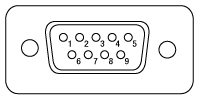
The RS-232 connector is included to support remote operation.
| Pin | Description |
|---|---|
| 1 | Not Connected |
| 2 | RS232 Input |
| 3 | RS232 Output |
| 4 | Not Connected |
| 5 | Digital Ground |
| 6 | Not Connected |
| 7 | Not Connected |
| 8 | Not Connected |
| 9 | Not Connected |
USB Type B Connector
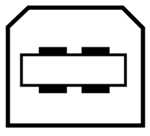
The USB connector is provided for firmware upgrades and future remote operation.
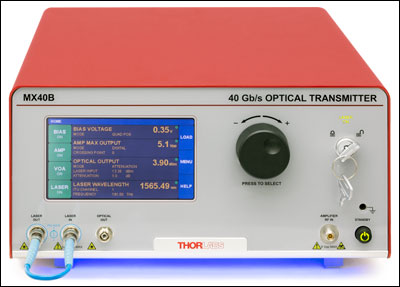
Click to Enlarge
Each reference transmitter offers the option to customize the color of the underbody accent lights or turn them off.
Included with Thorlabs' High-Speed Reference Transmitters:
- Optical Transmitter Main Unit
- Power Cord According to Local Supply (Determined by Ordering Location, Not Shown)
- PM Loop-Back Fiber Optic Cable
- SMA Loop-Back RF Cable (For the MX10B Series Only, Not Shown)
- Interlock Keys for Front Panel
- 2.5 mm Interlock Pin (Pre-installed in Back Panel, Not Shown)
- 1.25 A, 250 VAC Fuse (Not Shown)
- USB Type A to Type B Cable, 6' Long (Not Shown)
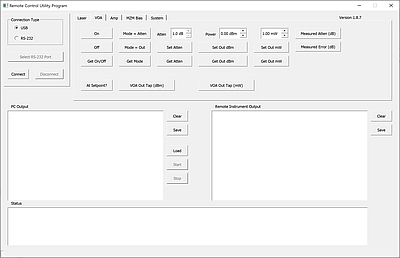
Click to Enlarge
The GUI of the Remote Control Software Tool
Software for the MX10B and MX40B Series of Reference Transmitters
Control Our Reference Transmitters Remotely via Serial Commands
Serial commands sent to the MX10B, and MX40B series of reference transmitters can control the functionality of the internal laser, RF amplifier, bias controller for the built-in modulator, and variable optical attenuator (VOA), as well as general system parameter settings. The commands can be sent from a computer running any operating system to the RS-232 port on the back panel of the reference transmitter. Computers running Windows® 7, or later versions of the operating system, can send serial commands to the USB port on the back panel of reference transmitter. The touchscreen interface remains active while the reference transmitter is controlled remotely. Descriptions of how to connect a controlling computer to the reference transmitter, the serial command set, and descriptions of each command are included in the Remote Control User Guide.
Application Demonstrating GUI-Based Remote Control of Our Reference Transmitters
The Remote Control Software Tool, which is available for download, is an example graphical user interface (GUI) provided for testing, demonstrating, and exploring the use of the different serial commands. This program is not required to operate the reference transmitter remotely. It opens a connection to the laser source and sends commands in response to buttons clicked by users. Commands sent to the reference transmitter, responses from it, and status information messages are logged to the three rectangular fields located beneath the buttons. Please see the Remote Control User Guide for more information. This program can be used as a basis for the development of custom applications. Please
Software
Version 1.8.9 (August 2, 2024)
Click on the link below to download the Remote Control Software Tool.
Laser Safety and Classification
Safe practices and proper usage of safety equipment should be taken into consideration when operating lasers. The eye is susceptible to injury, even from very low levels of laser light. Thorlabs offers a range of laser safety accessories that can be used to reduce the risk of accidents or injuries. Laser emission in the visible and near infrared spectral ranges has the greatest potential for retinal injury, as the cornea and lens are transparent to those wavelengths, and the lens can focus the laser energy onto the retina.
Safe Practices and Light Safety Accessories
- Laser safety eyewear must be worn whenever working with Class 3 or 4 lasers.
- Regardless of laser class, Thorlabs recommends the use of laser safety eyewear whenever working with laser beams with non-negligible powers, since metallic tools such as screwdrivers can accidentally redirect a beam.
- Laser goggles designed for specific wavelengths should be clearly available near laser setups to protect the wearer from unintentional laser reflections.
- Goggles are marked with the wavelength range over which protection is afforded and the minimum optical density within that range.
- Laser Safety Curtains and Laser Safety Fabric shield other parts of the lab from high energy lasers.
- Blackout Materials can prevent direct or reflected light from leaving the experimental setup area.
- Thorlabs' Enclosure Systems can be used to contain optical setups to isolate or minimize laser hazards.
- A fiber-pigtailed laser should always be turned off before connecting it to or disconnecting it from another fiber, especially when the laser is at power levels above 10 mW.
- All beams should be terminated at the edge of the table, and laboratory doors should be closed whenever a laser is in use.
- Do not place laser beams at eye level.
- Carry out experiments on an optical table such that all laser beams travel horizontally.
- Remove unnecessary reflective items such as reflective jewelry (e.g., rings, watches, etc.) while working near the beam path.
- Be aware that lenses and other optical devices may reflect a portion of the incident beam from the front or rear surface.
- Operate a laser at the minimum power necessary for any operation.
- If possible, reduce the output power of a laser during alignment procedures.
- Use beam shutters and filters to reduce the beam power.
- Post appropriate warning signs or labels near laser setups or rooms.
- Use a laser sign with a lightbox if operating Class 3R or 4 lasers (i.e., lasers requiring the use of a safety interlock).
- Do not use Laser Viewing Cards in place of a proper Beam Trap.
Laser Classification
Lasers are categorized into different classes according to their ability to cause eye and other damage. The International Electrotechnical Commission (IEC) is a global organization that prepares and publishes international standards for all electrical, electronic, and related technologies. The IEC document 60825-1 outlines the safety of laser products. A description of each class of laser is given below:
| Class | Description | Warning Label |
|---|---|---|
| 1 | This class of laser is safe under all conditions of normal use, including use with optical instruments for intrabeam viewing. Lasers in this class do not emit radiation at levels that may cause injury during normal operation, and therefore the maximum permissible exposure (MPE) cannot be exceeded. Class 1 lasers can also include enclosed, high-power lasers where exposure to the radiation is not possible without opening or shutting down the laser. |  |
| 1M | Class 1M lasers are safe except when used in conjunction with optical components such as telescopes and microscopes. Lasers belonging to this class emit large-diameter or divergent beams, and the MPE cannot normally be exceeded unless focusing or imaging optics are used to narrow the beam. However, if the beam is refocused, the hazard may be increased and the class may be changed accordingly. |  |
| 2 | Class 2 lasers, which are limited to 1 mW of visible continuous-wave radiation, are safe because the blink reflex will limit the exposure in the eye to 0.25 seconds. This category only applies to visible radiation (400 - 700 nm). |  |
| 2M | Because of the blink reflex, this class of laser is classified as safe as long as the beam is not viewed through optical instruments. This laser class also applies to larger-diameter or diverging laser beams. |  |
| 3R | Class 3R lasers produce visible and invisible light that is hazardous under direct and specular-reflection viewing conditions. Eye injuries may occur if you directly view the beam, especially when using optical instruments. Lasers in this class are considered safe as long as they are handled with restricted beam viewing. The MPE can be exceeded with this class of laser; however, this presents a low risk level to injury. Visible, continuous-wave lasers in this class are limited to 5 mW of output power. |  |
| 3B | Class 3B lasers are hazardous to the eye if exposed directly. Diffuse reflections are usually not harmful, but may be when using higher-power Class 3B lasers. Safe handling of devices in this class includes wearing protective eyewear where direct viewing of the laser beam may occur. Lasers of this class must be equipped with a key switch and a safety interlock; moreover, laser safety signs should be used, such that the laser cannot be used without the safety light turning on. Laser products with power output near the upper range of Class 3B may also cause skin burns. |  |
| 4 | This class of laser may cause damage to the skin, and also to the eye, even from the viewing of diffuse reflections. These hazards may also apply to indirect or non-specular reflections of the beam, even from apparently matte surfaces. Great care must be taken when handling these lasers. They also represent a fire risk, because they may ignite combustible material. Class 4 lasers must be equipped with a key switch and a safety interlock. |  |
| All class 2 lasers (and higher) must display, in addition to the corresponding sign above, this triangular warning sign. |  |
|

Janis Valdmanis, Ph.D. Optics
Ultrafast Optoelectronics
General Manager
Custom and OEM Options
When your application requirements are not met by our range of catalog products or their variety of user-configurable features, please contact me to discuss how we may serve your custom or OEM needs.
Request a Demo Unit
Explore the benefits of using a Thorlabs high-speed instrument in your setup and under your test conditions with a demo unit. Contact me for details.
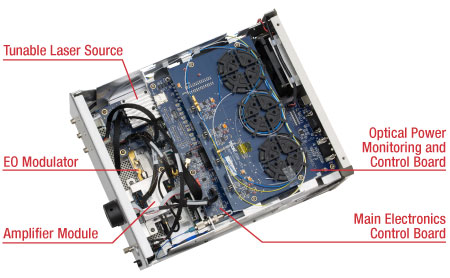
Click to Enlarge
The MX40B Digital Reference Transmitter
Design, Manufacturing, and Testing Capabilities
Thorlabs' Ultrafast Optoelectronics Team designs, develops, and manufactures high-speed components and instrumentation for a variety of photonics applications having frequency responses up to 110 GHz. Our extensive experience in high-speed photonics is supported by core expertise in RF/microwave design, optics, fiber optics, optomechanical design, and mixed-signal electronics. As a division of Thorlabs, a company with deep vertical integration and a portfolio of over 20,000 products, we are able to provide and support a wide selection of equipment and continually expand our offerings.
Our catalog and custom products include a range of integrated fiber-optic transmitters, modulator drivers and controllers, detectors, receivers, pulsed lasers, variable optical attenuators, and a variety of accessories. Beyond these products, we welcome opportunities to design and produce custom and OEM products that fall within our range of capabilities and expertise. Some of our key capabilities are:
- Detector and Receiver Design, to 70 GHz
- Fiber-Optic Transmitter Design, to 110 GHz
- RF & Microwave Design and Simulation
- Design of Fiber-Optic and Photonics Sub-Assemblies
- High-Speed Testing, to 110 GHz
- Micro-Assembly and Wire Bonding
- Hermetic Sealing of Microwave Modules
- Fiber Splicing of Assemblies
- Custom Laser Engraving
- Qualification Testing
Overview of Custom and Catalog Products
Our catalog product line includes a range of integrated fiber-optic transmitters, modulator drivers and controllers, detectors, pulsed lasers, and accessories. In addition to these, we offer related items, such as receivers and customized catalog products. The following sections give an overview of our spectrum of custom and catalog products, from fully integrated instruments to component-level modules.
Fiber-Optic Instruments
To meet a range of requirements, our fiber-optic instruments span a variety integration levels. Each complete transmitter includes a tunable laser, a modulator with driver amplifier and bias controller, full control of optical output power, and an intuitive touchscreen interface. The tunable lasers, modulator drivers, and modulator bias controllers are also available separately. These instruments have full remote control capability and can be addressed using serial commands sent from a PC.
- Fiber-Optic Transmitters, to 110 GHz
- Linear and Digital Transmitters
- Electrical-to-Optical Converters, to 110 GHz
- Modulator Drivers
- Modulator Bias Controllers
- C- and L-Band Tunable Lasers
Customization options include internal laser sources, operating wavelength ranges, optical fiber types, and amplifier types.
Fiber-Optic Components
Our component-level, custom and catalog fiber-optic products take advantage of our module design and hermetic sealing capability. Products include detectors with frequency responses up to 50 GHz, and we also specialize in developing fiber-optic receivers, operating up to and beyond 40 GHz, for instrumentation markets. Closely related products include our amplifier modules, which we offer upon request, variable optical attenuators, microwave cables, and cable accessories.
- Hermetically-Sealed Detectors, to 50 GHz
- Fiber-Optic Receivers, to 40 GHz
- Amplifier Modules
- Electronic Variable Optical Attenuators
- Microwave Cables and Accessories
Customization options include single mode and multimode optical fiber options, where applicable, and detectors optimized for time or frequency domain operation.
Free-Space Instruments
Our free-space instruments include detectors with frequency responses around 1 GHz and pulsed lasers. Our pulsed lasers generate variable-width, nanosecond-duration pulses, and a range of models with different wavelengths and optical output powers are offered. User-adjustable repetition rates and trigger in/out signals provide additional flexibility, and electronic delay-line products enable experimental synchronization of multiple lasers. We can also adapt our pulsed laser catalog offerings to provide gain-switching capability for the generation of pulses in the 100 ps range.
- Pulsed Lasers with Fixed 10 ns Pulse Duration
- Pulsed Lasers with Variable Pulse Width and Repetition Rates
- Electronic Delay Units to Synchronize NPL Series Pulsed Lasers
- Amplified Detectors
Customization options for the pulsed lasers include emission wavelength, optical output powers, and sub-nanosecond pulse widths.
| Posted Comments: | |
akg
(posted 2018-12-27 01:24:09.213) I have one more query on MX40B. Is this possible to have it with higher extinction
ratio. The mentioned specs are 13dB (Typical Maximum) and I am looking for extinction
ratio of around 40dB. What is the maximum guaranteed extinction ratio that can be
supported by Thorlabs? Request you to confirm the same. YLohia
(posted 2018-12-27 10:27:20.0) The limitation on extinction ratio for the MX40B is the lithium niobate intensity modulator. Our standard modulators only guarantee an extinction ratio of 13dB. It may be possible to get a higher extinction-ratio modulator, but ~40dB may be hard to do. Please email techsupport@thorlabs.com for future requests on customizations. akg
(posted 2018-10-21 23:10:53.867) Hello,
My understanding is that the Amplifier RF input is single ended. I hope my understanding is correct. I raised this query because the specifications mentioned "Amplifier RF Input" as peak to peak.
regards
Atul YLohia
(posted 2018-10-22 12:43:12.0) Hello again Atul, the definitions that we’re using for the two terms in question are:
Single Ended: The amplifier takes a single 50 Ohm input. This is in contrast to a differential input signal, which would be two 50 Ohm inputs that are positive and negative (inverting and non-inverting inputs).
Voltage Peak to Peak: This references a measurement of the amplitude of the signal, as contrasting with Vrms or Vamp
The MX40B has a single input, whose nominal and maximum input RF voltages we specify as a peak to peak voltage. akg
(posted 2018-09-18 01:27:14.563) Hello,
In my application I want to connect MX40B optical output (modulated) to the optical input of MX40C. Can I get MX40B with Polarization Maintaining Fiber Output which can be connected with MX40C PMF input. YLohia
(posted 2018-09-18 08:21:48.0) Hello, you can use a single mode PM fiber (FC/PC connectorized) to connect the Optical Out port of the MX40B to the Laser In port of the MX40C. You can use the fiber supplied with the MX40C to do this. Alternately, if you require a longer length of fiber, please use our online custom fiber patch cable configuration tool here (https://www.thorlabs.com/newgrouppage9.cfm?objectgroup_id=2410) to select your custom length for the PM1550-XP fiber. akg
(posted 2018-09-14 01:25:31.027) Hello,
I want to know how the linewidth of the laser inside MX10B/MX40B compare with that of Thorlab's SFL1550S. Which of the laser is better from linewidth perspective. From the data sheet the maximum linewidth for MX10B/MX40B and SFL1550S are 15KHz and 100KHz. Is the definition for the linewidth used in both the cases identical and laser of MX10B/MX40B better than that of SFL1550S? Please confirm. YLohia
(posted 2018-09-17 11:07:53.0) Hello, thank you for contacting Thorlabs. As far as linewidth goes, the laser in MX10B/MX40B would be smaller. The linewidth in both cases is characterized by the full width half max (FWHM). The 15 kHz and 100 kHz are the absolute max specs -- typically, the linewidth for both are better (~10 kHz and 50 kHz, respectively). |
Choose Optical Transmitter by Application
- Beginning at the left side of the table, choose your desired system characteristics.
- Follow the table to the right and continue to select characteristics from the options within the same row as your previous selection.
- After reaching a Base Item #, choose a laser type. Your system's item # will be your base item # combined with the suffix for your laser type, e.g. MX40B-1310.
| Start Here | Follow the Table to the Right and Choose From These Options | Find Your System Here | ||||
|---|---|---|---|---|---|---|
| Modulator Type | Primary Application | Modulation Format | Speed | RF Input | Base Item # | Item # Suffix: Laser Type |
| Amplitude | Time Domain / Eye Diagram | Linear / 4-Level PAM4 | 32 GBaud | Differential | MX35D | No Suffix: C-Band Tunable Laser -LB: L-Band Tunable Laser -1310: 1310 nm Fixed Laser -850: 850 nm Fixed Lasera,b |
| Single Ended | MX35E | |||||
| 56 GBaud | → | MX65E | ||||
| 115 GBaud | → | MX100E | ||||
| Digital / 2-Level NRZ / OOK | 10 Gbps | → | MX10B | |||
| 40 Gbps | → | MX40B | ||||
| 56 Gbps | → | MX50E | ||||
| 56 Gbps | → | MX65E | ||||
| 115 Gbps | → | MX100E | ||||
| Frequency Domain / VNA | → | 40 GHz | → | MX40G | ||
| 70 GHz | → | MX70G | ||||
| 110 GHz | → | MX110G | ||||
| Phase | → | → | 10 Gbps | → | MX10C | |
| 40 Gbps | → | MX40C | ||||
Choose Optical Transmitter Instrument by Features
| Transmitter Instruments and Tunable Lasers | |||||||
|---|---|---|---|---|---|---|---|
| Item # | Speed | Internal Laser | Internal Modulator (Type) |
RF Amplifier (Type) |
Bias Controller |
Variable Optical Attenuator (VOA) |
Block Diagram |
| Automatic Bias Controller | |||||||
| MBX2 (770 - 980 nm) |
N/A | - | - | - | |||
| MBX3 (980 - 1310 nm) |
N/A | - | - | - | |||
| MBX (1250 - 1610 nm) |
N/A | - | - | - | |||
| Tunable Telecom-Grade Laser Sources | |||||||
| TLX1 | N/A | C-Band, Tunable | - | - | - | ||
| TLX2 | N/A | L-Band, Tunable | |||||
| High-Speed Modulator Drivers | |||||||
| MX10A (1250 - 1610 nm) |
12.5 Gb/sa | - | - | Digital | |||
| MX40A (1250 - 1610 nm) |
40 Gb/sa | ||||||
| High-Speed Optical Transmitters | |||||||
| MX10B | 12.5 Gb/sa | C-Band, Tunable | Intensity | Digital | |||
| MX10B-LB | 12.5 Gb/sa | L-Band, Tunable | |||||
| MX10B-1310 | 12.5 Gb/sa | 1310 nm, Fixed | |||||
| MX10C | 12.5 Gb/sa | C-Band, Tunable | Phase | Digital | - | ||
| MX10C-LB | 12.5 Gb/sa | L-Band, Tunable | |||||
| MX10C-1310 | 12.5 Gb/sa | 1310 nm, Fixed | |||||
| MX35E | 35 GHzb | C-Band, Tunable | Intensity | Linear | |||
| MX35E-LB | 35 GHzb | L-Band, Tunable | |||||
| MX35E-1310 | 35 GHzb | 1310 nm, Fixed | |||||
| MX35D | 35 GHzb | C-Band, Tunable | Intensity | Linear with Differential Input |
|||
| MX35D-LB | 35 GHzb | L-Band, Tunable | |||||
| MX35D-1310 | 35 GHzb | 1310 nm, Fixed | |||||
| MX40B | 40 Gb/sa | C-Band, Tunable | Intensity | Digital | |||
| MX40B-LB | 40 Gb/sa | L-Band, Tunable | |||||
| MX40B-1310 | 40 Gb/sa | 1310 nm, Fixed | |||||
| MX40C | 40 Gb/sa | C-Band, Tunable | Phase | Digital | - | ||
| MX40C-LB | 40 Gb/sa | L-Band, Tunable | |||||
| MX40C-1310 | 40 Gb/sa | 1310 nm, Fixed | |||||
| MX50E-850 | 50 GHzb | 852 nm, Fixed | Intensity | Linear | |||
| MX65E | 65 GHzb | C-Band, Tunable | Intensity | Linear | |||
| MX65E-LB | 65 GHzb | L-Band, Tunable | |||||
| MX65E-1310 | 65 GHzb | 1310 nm, Fixed | |||||
| MX100E | 100 GHzb | C-Band, Tunable | |||||
| MX100E-1310 | 100 GHzb | 1310 nm, Fixed | |||||
| E-O Converters for VNA Applications | |||||||
| MX40G | 40 GHzb | C-Band, Tunable | Intensity | - | |||
| MX40G-LB | 40 GHzb | L-Band, Tunable | |||||
| MX40G-850 | 40 GHzb | 850 nm, Fixed | |||||
| MX40G-1310 | 40 GHzb | 1310 nm, Fixed | |||||
| MX70G | 70 GHzb | C-Band, Tunable | Intensity | - | |||
| MX70G-LB | 70 GHzb | L-Band, Tunable | |||||
| MX70G-1310 | 70 GHzb | 1310 nm, Fixed | |||||
| MX70G-DB1 | 70 GHzb | C-Band, Tunable | Intensity | - | |||
| 1310 nm, Fixed | |||||||
| MX110G | 110 GHzb | C-Band, Tunable | Intensity | - | |||
| MX110G-1310 | 110 GHzb | 1310 nm, Fixed | |||||
The capabilities of Thorlabs' extensive range of transmitter instruments are summarized in the text and table below. All members of this product series share a similar interface, as well as a common remote control command set.
Automatic Bias Controller
Thorlabs' fully-featured automatic bias controllers provide complete and precise control of DC bias and optical output power for any fiber-coupled LiNbO3 EO intensity modulator, regardless of signal speed. Automatic bias controllers are ideal for use within a customized setup that uses an external laser, intensity modulator, signal source, and RF amplifier. Options are available for wavlengths from 770 nm up to 1610 nm.
Tunable Telecom-Grade Laser Sources
Emitting in the C-band or the L-band, these lasers have narrow typical linewidths of 10 kHz. A frequency dither option aids in stabilizing the laser wavelength, and the integrated variable optical attenuator (VOA) provides optical output power control. These lasers are tunable in 50 GHz steps across the ITU frequency grid, and feature a 1 MHz step size fine-tune capability, as well.
High-Speed Modulator Drivers
With an operational wavelength range of 1250 nm to 1610 nm, each modulator driver provides control for an external fiber-coupled LiNbO3 EO modulator. Each modulator driver includes an RF amplifier with amplitude and eye-crossing controls and accepts an external drive signal source. Models with integrated automatic bias controllers are offered for use with intensity EO modulators.
High-Speed Optical Transmitters
Designed to provide fully-integrated solutions for high-speed light modulation, these systems are built around a LiNbO3 intensity or phase modulator. The MX10B, MX40B, MX10C, and MX40C series of systems include a digital (limiting) RF amplifier, which offers fixed gain and an adjustable output voltage swing. The MX35E, MX50E, MX65E, and MX100E series include a high-bandwidth linear (analog) RF amplifier, making it well suited for pulse amplitude modulation and related applications.
E-O Converters for VNA Applications
With our MX40G, MX70G, and MX110G series of E-O converters, any E-E vector network analyzer can be used to perform optical testing up to 40 GHz, 70 GHz, and 110 GHz respectively. The E-O converter is a fully-integrated solution that includes a laser, a modulator, and bias control.

| Key System Specificationsa | ||||
|---|---|---|---|---|
| Item # | MX10B | MX10B-LB | MX10B-1310 | |
| Bit Rate (Maximum) | 12.5 Gb/s | |||
| Internal Laser Typeb | C-Band, Tunable | L-Band, Tunable | Fixed Wavelength | |
| Internal Laser Wavelengthb | 1527.6 - 1565.5 nm | 1570.0 - 1608.8 nm | 1310 nm | |
| RF Amplifier Gain | 34 dB | |||
| Small Signal Bandwidth | 7 GHz | |||
- For Applications up to 12.5 Gb/s
- User-Adjustable RF Amplifier Output Swing
- Multiple Integrated Internal Laser Options*
- C-Band Laser Tunable on ITU 50 GHz Grid
- L-Band Laser Tunable on ITU 50 GHz Grid
- 1310 nm Fixed-Wavelength Laser
The MX10B series digital transmitters can operate up to 12.5 Gb/s and include an external loop-back cable for connecting the RF output to the modulator input. This feature allows the user to use an external modulator driver, if desired (see the Front & Back Panels tab for details).
*An 850 nm fixed-wavelength laser is also available upon request. Please contact Tech Support for details.

| Key System Specificationsa | ||||
|---|---|---|---|---|
| Item # | MX40B | MX40B-LB | MX40B-1310 | |
| Bit Rate (Maximum) | 40 Gb/s | |||
| Internal Laser Typeb | C-Band, Tunable | L-Band, Tunable | Fixed Wavelength | |
| Internal Laser Wavelengthb | 1527.6 - 1565.5 nm | 1570.0 - 1608.8 nm | 1310 nm | |
| RF Amplifier Gain | 30 dB | |||
| Small Signal Bandwidth | 20 GHz | |||
- For Applications up to 40 Gb/s
- User-Adjustable RF Amplifier Output Swing
- Multiple Integrated Internal Laser Options*
- C-Band Laser Tunable on ITU 50 GHz Grid
- L-Band Laser Tunable on ITU 50 GHz Grid
- 1310 nm Fixed-Wavelength Laser
The MX40B series digital transmitters support bit rates up to 40 Gb/s and have a direct internal connection from the amplifier to the modulator.
*An 850 nm fixed-wavelength laser is also available upon request. Please contact Tech Support for details.
 Products Home
Products Home

























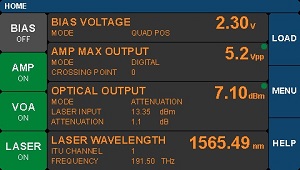


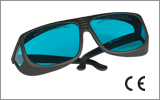
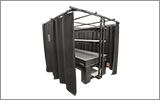
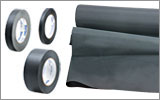

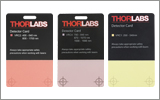
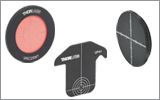
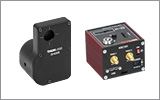
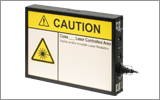












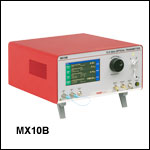
 Zoom
Zoom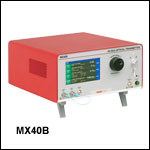
 Fiber-Optic Digital Reference Transmitters
Fiber-Optic Digital Reference Transmitters